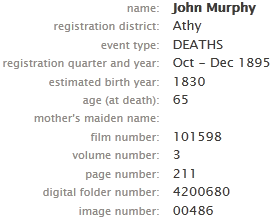My mum in law is very into genealogy, and managed to get me hooked on it when I was on maternity leave a couple of years ago. Well, for the couple of months before baby arrived, at least: once he was here, all time for such things went out the window. But I’m finally finding a few spare moments now to get back into it.
There’s more and more information becoming available online all the time, so you can do a lot from the comfort of your home. I’ve managed to fill in the direct line back as far as quite a few of my great-great-great grandparents on both sides now, with most of the info coming from online, and I’m starting to fill in brothers and sisters.
So, while I’m in the zone, I thought I’d share a few of the resources I’ve been using, and maybe you’ll get the bug too.
First off, some free sites that will get you started:
- The National Archives Censuses of 1901 and 1911. These are a good place to start, as chances are you’ll be able to ask living relatives for enough information to find definite matches. In both censuses ,on the A form you’ll get the registered people’s full names, relationship to head of household, religion, literacy level, age, profession, marital status, birthplace, use of the Irish language, and whether they have one of a specified list of disabilities. The 1911 census includes a wee bit more information: how many years of marriage are completed, total number of children born alive, and number of children still living. If you’re happy you’ve got a match, you can take a look at the B forms too, and find out more about the house and extended property your ancestors lived in/on.
- If you’re lucky enough to have ancestors in Carlow (CoI only), Cork & Ross (RC only), Dublin or Kerry, Irish Genealogy have digitised church records for these areas, so you may be able to track down births, deaths and marriages for some of the people you’ve found in the censuses. If you say you want to see births for a certain name, you’ll be shown all birth records that include that name, either as the child, a parent or a sponsor. There was a tendency back in the day (in my family at least!) to have a bundle of children about two years apart, so once you’ve found a birth and parent names for one ancestor, you can search for one or both of the parents on birth records in or around the same timeframe to get a set of siblings. Relatives often stood as sponsors, so recurring names here can tip you off to further family connections.
 FamilySearch.org is a service provided by The Church of Jesus Christ of Latter-day Saints, aka the Mormons. It’s very thorough, and you stand a very good chance of finding something useful on here. The type of information returned depends on the resource. There’ll always be some kind of textual summary, and there may be a link or reference to where you can find more information (free or paid). For Irish births, deaths and marriages, keep an eye out for returns that show an event type, name, registration district, quarter and year, volume number and page number (as illustrated above for a random John Murphy – no relation). Jot these down, make your way to the General Register Office (GRO) in the Irish Life Mall between Talbot St and Abbey St in Dublin, and for the princely sum of €4, you can get a copy of the original registration entry for the event, which will contain more information to help you identify whether or not this is the person you’re looking for, and hopefully point you in the direction of more people to follow up. If you’re trying to do things on the cheap and are looking for marriage records, do this search for both husband and wife – if you get a match on district, year, quarter, volume and page, chances are you’ve found the pair.
FamilySearch.org is a service provided by The Church of Jesus Christ of Latter-day Saints, aka the Mormons. It’s very thorough, and you stand a very good chance of finding something useful on here. The type of information returned depends on the resource. There’ll always be some kind of textual summary, and there may be a link or reference to where you can find more information (free or paid). For Irish births, deaths and marriages, keep an eye out for returns that show an event type, name, registration district, quarter and year, volume number and page number (as illustrated above for a random John Murphy – no relation). Jot these down, make your way to the General Register Office (GRO) in the Irish Life Mall between Talbot St and Abbey St in Dublin, and for the princely sum of €4, you can get a copy of the original registration entry for the event, which will contain more information to help you identify whether or not this is the person you’re looking for, and hopefully point you in the direction of more people to follow up. If you’re trying to do things on the cheap and are looking for marriage records, do this search for both husband and wife – if you get a match on district, year, quarter, volume and page, chances are you’ve found the pair.
OK – now I’ve started you down the spending money path, so let’s break and reconvene another time to look at a few more resources.


3 thoughts on “Researching your Irish Family Tree – Part 1”
Comments are closed.